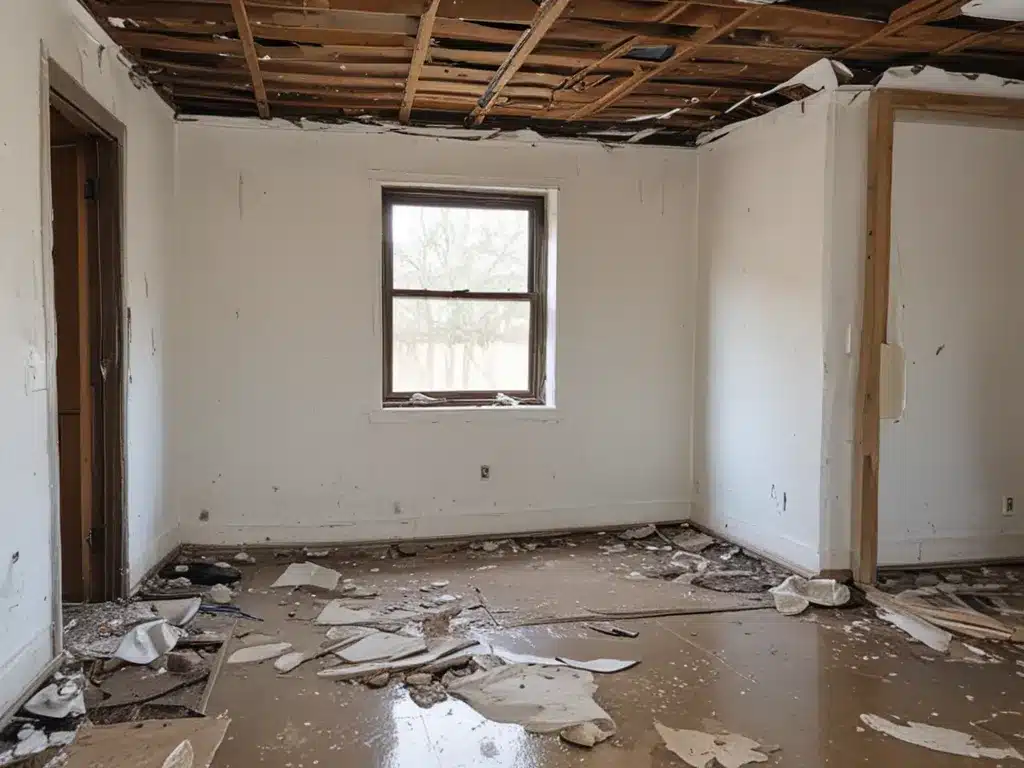Assess the Damage
The first step is to carefully assess the damage to your property. This will help determine the necessary steps for repairs.
- Walk through each room and make notes about the type and extent of damage. Pay close attention to the structural integrity of the building.
- Take photographs to document the damage for insurance claims.
- Look for water stains, smoke damage, warped floors or walls, and mold growth.
- Check electrical systems, appliances, and plumbing for proper functionality.
- Identify personal belongings that are damaged beyond repair.
Performing a thorough initial damage assessment will provide a clear overview of the restoration work needed.
Contact Your Insurance Provider
Contact your insurance company as soon as possible after the incident.
- Inform them of the event and known extent of damages.
- Discuss your coverage and options for financial assistance.
- Ask about recommending or providing remediation contractors.
- Learn what steps are required for reimbursement.
- Keep notes about all conversations and get confirmation in writing whenever possible.
Prompt communication with your insurer can facilitate rapid repairs and reimbursement.
Document the Damage
Thorough documentation is crucial for insurance claims and dealing with contractors.
- Take clear photos and videos showing all damage.
- Save samples of damaged materials.
- Keep records of conversations with insurance representatives and contractors.
- Hold onto receipts for expenses related to cleanup and repairs.
- Track costs for labor, materials, accommodations, and belongings.
Complete documentation provides proof needed to justify insurance reimbursement.
Safely Clean and Dry Out
Reducing moisture is a critical first step in restoration.
- Remove or open soaked materials to aid drying.
- Run fans and dehumidifiers throughout damaged areas.
- Discard porous items that cannot quickly dry out.
- Clean surfaces with an antimicrobial solution to inhibit mold.
- Wear protective gear during cleanup to avoid health hazards.
- Dry out walls by removing lower sections of water-damaged drywall.
Thoroughly drying and cleaning the structure helps stabilize damage before repairs.
Schedule Inspections and Permits
Inspections and permits ensure repairs meet building codes.
- Arrange visits from building inspectors to evaluate electrical, structural and plumbing systems.
- Apply for necessary permits for major repairs.
- Follow regulations for necessary demolition work prior to disposal.
- Obtain documentation from inspectors showing systems are safe for re-occupancy.
- Perform environmental tests for lingering contamination if there was flooding.
Proper inspections and permits mitigate long-term safety risks and liabilities.
Hire Reputable Contractors
Reputable contractors possess the expertise to facilitate high-quality repairs.
- Verify credentials, insurance coverage, and license status.
- Ask for references from recent jobs and follow up.
- Compare several quotes to find competitive pricing.
- Review contracts thoroughly and clarify any uncertainties.
- Establish a clear timeline for completion of work.
- Do not pay final balance until work has been inspected.
Vetting contractors thoroughly reduces chances of shoddy or incomplete work.
Prioritize Repairs
Strategically prioritizing repairs can make the process faster and more efficient.
- Focus first on fixes needed to prevent further damage, such as roofing or plumbing leaks.
- Restore power, heat, and water early in the process to enable other work.
- Repair exterior and structural damage before dealing with surfaces and aesthetics.
- Replace insulation and drywall to establish a sealed, climate controlled interior.
- Hold off on replaceable furnishings and non-essential appliances until the end.
An orderly sequence of repairs should maximize function quickly and minimize disruptions.
Create a Repair Schedule
A comprehensive repair schedule keeps the projects on task and budget.
- Outline all repair tasks with assigned deadlines for completion.
- Note which items require lead times for ordering materials.
- Identify preceding steps that must be done before certain tasks.
- Build in contingency time for potential delays.
- Coordinate work between different contractors.
- Establish checkpoints for inspections at key milestones.
With an organized schedule, contractors can work efficiently and delays can be promptly addressed.
Monitor Repairs and Budget
Closely overseeing the repair process prevents cost overruns and issues.
- Make frequent site visits to inspect progress and quality.
- Review invoices from contractors to confirm accuracy.
- Compare expenses to the repair budget to avoid cost surprises.
- Address problems promptly to avoid delays.
- Maintain open communication with all parties involved.
- Document discussions, changes, and expenses.
Staying engaged ensures contractors complete quality work according to the agreed upon budget and timeline.
Make Temporary Living Arrangements
For extensive repairs, temporary accommodations may be necessary.
- Determine how long repairs may take and when re-occupancy is possible.
- Arrange a rental nearby or stay with family/friends if possible.
- Forward mail and suspend non-essential services at your damaged residence.
- Move valuables and vital documents to secure storage if needed.
- Maintain access to the property for meetings with contractors.
- Pack essentials like clothes, toiletries, and medications.
Temporary lodging helps provide the full access contractors need for repairs while allowing some sense of normalcy.
Restock Supplies After Completion
Once repairs reach completion, restocking supplies makes the space functional again.
- Replace spoiled or damaged food items.
- Shop for household cleaners appropriate for refreshed surfaces.
- Refill prescriptions that may have been lost or left behind.
- Purchase items to replace damaged furniture and linens.
- Contact service providers to restart television, internet, and phone service.
- Update your address if you relocated during repairs.
With all basic household items replenished, you can comfortably move back into your restored home.
Careful documentation, contracting, budgeting, and project oversight will help critical flood and fire damage repairs go as smoothly as possible. Maintaining good records and communication can streamline the insurance claims process. While the damage restoration process involves many challenges, your perseverance will ultimately make the space livable once again.







